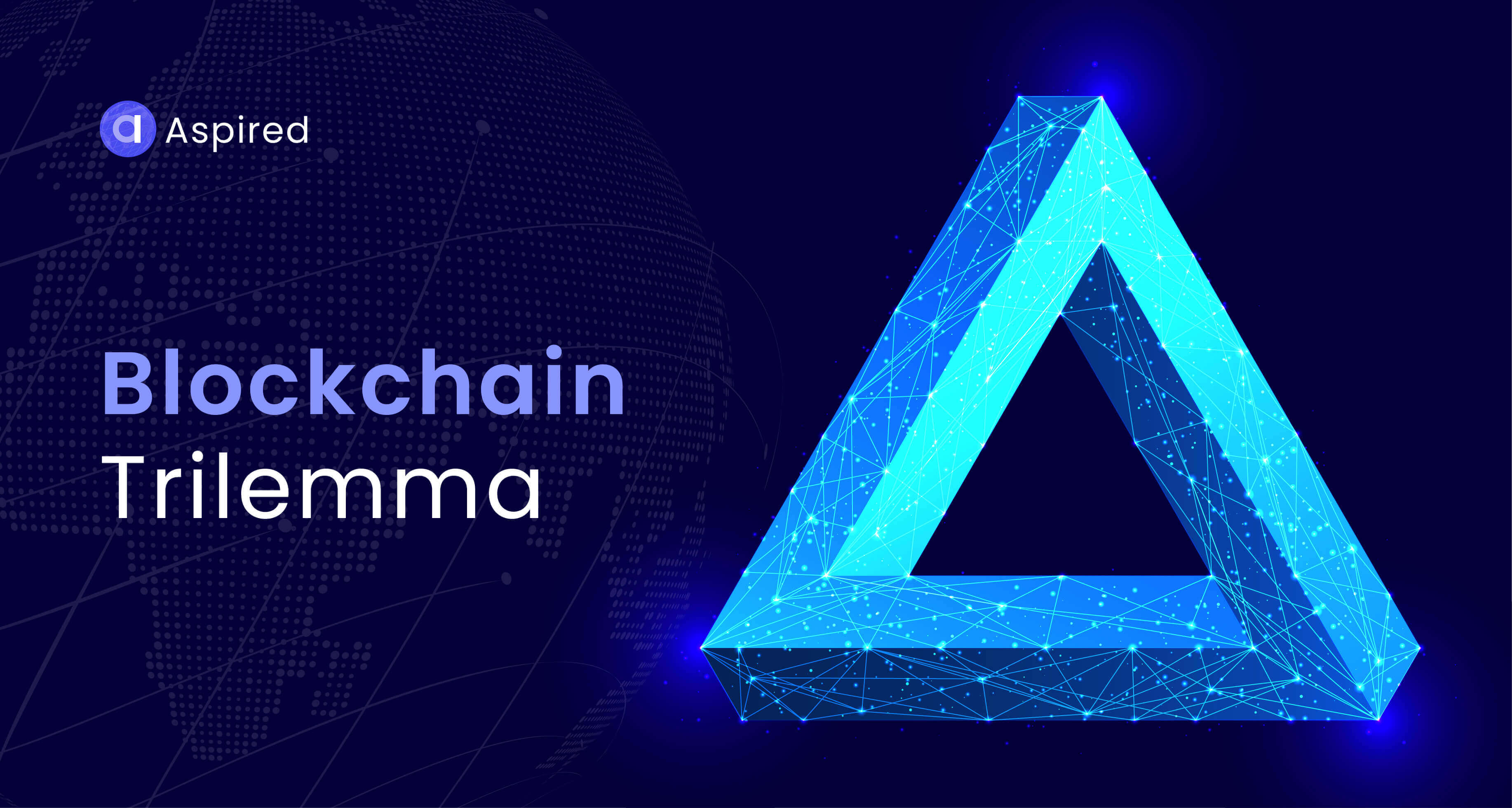Bitcoin's birth was probably the biggest breakthrough the world of technology saw in the last decade. For the first time, a value transaction between two parties without a double-spending problem was made possible without a central entity involved. The idea alone that value exchange would be possible regardless of data size with trust minimalization in a decentralized space is so powerful and revolutionary in itself.
Like many other things around us, the practical implementation of this idea saw a huge limitation soon after blockchain's enormous take-off in 2014 . Decentralization, security, and scalability are the three main pillars on which blockchain technology is built, and these three aspects of the technology interact to create and sustain a functional network.
The issue, though, is this. No public blockchain network can manage increasing nodes while utilizing decentralized consensus mechanisms and still have sound throughput and speed. To say the least, a blockchain network can only choose two from the three; transparency, equitability, and open access at a given time.
However, to understand the trilemma better, we will have to revisit a similar problem that arrived in the early eighties and dealt with distributed data. But don't worry, this blog will not just talk about the challenge and its different aspects. In fact, by the end of this blog, you will get your hands on some of the most promising solutions to this problem.
When Did it All Start?
When system design was in full swing in the 80s, and more and more computer enthusiasts were inclining towards distributed data and communication via distributed systems, computer scientists found a unique challenge. The issue with distributed data was that upon a break in communication between the nodes, either the readers can read the latest data or the data is made available across the nodes regardless its recency.
Eric Brewer presented the challenge in 2000 as the CAP theorem, which explains the major trade-off between consistency, availability, and partition tolerance. The theorem serves as the basis of the network systems today. It helps designers determine how the network will behave if a certain number of nodes refuse to communicate due to some fault in the system.
Fast forward to today, distributed networks is replaced by decentralized networks. Consistency, availability, and partition tolerance are now decentralization, scalability, and security, and the CAP theorem now is iterated as Blockchain Trilemma.
Public blockchain networks use decentralized consensus mechanisms instead of the client-server setup that are the key in central network infrastructures. Public blockchains are reliant on a widely dispersed network of nodes to reach data consensus across a secure infrastructure while upholding open-source status, data security, and transparency. That's difficult.
For instance: Icon, being one of the most secure blockchains, is completely decentralized, making it the most trustable crypto blockchain. But guess what? Its sluggish transaction speed and overall process energy stand between its scalability plans. On the contrary, Polkadot , a relatively new enterprise, offers a very secure network with exceptionally high transaction speed. The reason behind this is its centralized approach with a limited number of nodes.
What Is the Blockchain Trilemma?
The term ‘blockchain trilemma’ was coined by Vitalik Buterin , the founder of Ethereum, who believed that for a blockchain network to level up, it will have to sacrifice one thing out of scalability, security, and decentralization.
It is firmly believed that a completely decentralized network can only achieve its desired levels of scalability by compromising the security and transaction speed in the process. Since blockchains rely on consensus mechanisms instead of client-server relationships for validating data and its transfer, maintaining equitability, transparency, and maximum security simultaneously is a huge challenge.
Put simply; the blockchain trilemma is a problem that arises from the inherent contradictions in blockchain technology. Namely, those blockchains are simultaneously secure, decentralized, and scalable. Unfortunately, these three features often conflict, leading to trade-offs and difficult decisions about how to best proceed.
In simpler words, you can only have two out of three of these characteristics at any given time. So, for example, if you want a decentralized network, it will be more difficult to achieve scalability. Or, if you want a scalable network, it will be more centralized.
There are several proposed solutions to the blockchain trilemma, but none are without their drawbacks. In this write-up, we'll take a closer look at the trilemma and explore some of the possible solutions.
What Makes Blockchain Trilemma So Difficult?
Blockchain giants like Bitcoin and Ethereum have successfully dominated the factors of decentralization and security but are looking clueless on the question of scalability. Hence, the widespread adaptation that will channel the centralized financial institutions into these networks is nearly impossible to achieve.
Althhough these blockchain networks are pulling in huge amounts of money and resources to find an absolute solution to the blockchain trilemma, this puzzle is still far from 100% resolution. There are, however, a few possible solutions to this problem, which we will cover in further depth below. But first, let's take a look at why these three characteristics that constitute this trilemma are so important.
Decentralization
The first part of the Blockchain Trilemma is decentralization. Decentralization is key to the success of any blockchain project. It ensures that there is no single point of failure and that the network is resistant to attack.
Decentralized procedures and technologies minimize and even eliminate the role of middlemen across sectors. When it comes to centralized finance; banking institutions typically act as intermediaries providing services and charging a fee for those services. With Decentralization, the prospect of sharing earnings and governance with consumers and the greater community rather than the intermediaries is finally a practical reality However, decentralization comes at a cost. The more decentralized a network is, the slower it becomes. This is because each node on the network needs to process every transaction.
Security
Blockchain security aims to save crypto investments from malicious hacking attempts by implementing robust consensus mechanisms like proof-of-stake (POS) and proof-of-work (POW), making Bitcoins and Ethereum nearly 'impossible' to hack.
The strength of a POW blockchain security arrangement lies in the number of total miners on the blockchain. Therefore, the only way to breach a POW System security is to attain more than 50% of the mining power of a blockchain network (51% Attack).
Precisely, security is a necessity for a blockchain to be trustworthy and successful because, without it, the possibility of losing your valuable assets to attackers becomes a very obvious setup.
Scalability
Scalability is the ability of blockchain technology to accommodate high transactional throughput and future growth without significant increases in fees and without sacrificing performance. Blockchains will likely perform badly as usage grows due to the higher weight of transactions going back and forth to the nodes.
Scalability is necessary for blockchain networks to compete with legacy centralized platforms, which currently have considerably greater network settlement speeds and usability. But with intensifying the scalability, security decentralization or both would suffer as a result, according to the blockchain trilemma.
While several blockchain systems have established decentralization and security, today's leading defined networks like Ethereum and Bitcoin have significant challenges regarding scalability.
Different Approaches to the Blockchain Trilemma Solution
Solana (SOL)
Solana has found a potential solution to blockchain trilemma using Proof-of-Stake (POS) consensus mechanism and enterprise grade servers. What it means is instead of getting consensus form all the nodes on the network, Solana only utilizes a small number of servers in its processing cluster to get to blockchain decentralization.
It has enabled Solana not only to speed up its transaction speed up to 65,000 transactions per second but also scale it faster while maintaining the network security. The downside, however, is that the average price required to be part of its processing cluster is $10,000. Something, that only a little segment of investors can afford. This hampers the decentralization efforts and lands questions on the future of Solana.
Polkadot (DOT)
Polkadot uses a unique data availability and validity solution that enables interpretability between multiple blockchains which makes it more efficient and decentralized. Because a number of networks can connect to this blockchain easily, Polkadot’s Relay Chain makes sure the network is always secure and scalable.
Polkadot also used Parachains that run parallel to this blockchain and give it an edge over other networks whereby maximizing security, scalability, and lowering gas fees. Polkadot’s advantage over Solana is its validator’s network that comes into play for achieving all-out consensus upholding its decentralized nature.
Algorand
Algorand is another coin that was launched last year and promises to have found a unique solution to blockchain trilemma. Algorand uses Proof-of-Stake (PoS) where only cryptographically chosen validators can stake their tokens for validating the next block. This cuts down the number of validating notes by a few exponents multiplying the transaction speed and block security.
Algorand has been able to achieve this using a unique “verifiable random function” (VRF). An idea which randomly selects a node to be in charge of 1000 token committee. The selection takes microsecond and the chosen nodes propagate the proof of being selected. Since nobody knows in advance would be selected in advance, the network cannot be corrupted by any means.
Possible Solutions to the Blockchain Trilemma
But what are some possible solutions to this problem? To understand these solutions better, we must categorize them into Layers 1 and 2. Let's take a look at a few of these promising solutions:
Layer 1
Layer 1 refers to a base blockchain, so a layer one solution would improve the blockchain itself. Bitcoin, Ethereum, Solana, and the BNB smart chain are examples of layer-one networks. There are the following notable ways to improve layer one networks.
Change in Consensus Mechanism
The consensus mechanism currently used on major blockchain networks such as Bitcoin and Ethereum is proof of work. Although proof of work is the most secure consensus mechanism, it is also time-consuming. Bitcoin, for example, can only achieve around seven transactions per second, while Ethereum can perform between 15 and 20.
On the contrary, many newer blockchain networks achieve consensus through proof of stake. It is considerably faster and even more environmentally friendly. Ethereum is upgrading from proof of work to proof of stake and could achieve speeds of up to 100,000 transactions per second.
Rollups
Rollups are a novel scaling solution that aims to help Bitcoin scaling by increasing on-chain capacity without jeopardizing security or decentralized properties. Rollups work by bundling multiple transactions together into a single "rollup" transaction, which is then committed to the main chain.
Sharding
Another solution that's been proposed is sharding, which is basically when you take a big database and break it up into smaller pieces, or shards. So instead of having one huge blockchain that everyone has a copy of, you would have numerous small blockchains.
The idea is that this would make the network faster because each node wouldn't have to process the entire blockchain, just the part that pertains to them. The downside is that sharding can be tricky to implement, and it still needs to be clarified if it would work in practice.
Layer 2
layer two solutions involve secondary frameworks or protocols built on top of existing blockchain systems. While there are several different Layer 2 solutions, we'll cover the top three only:
Nested Blockchains
With Nested Blockchains, there would be the main blockchain to which all the other, smaller blockchains are anchored. The idea is that each blockchain would have its token, but these tokens would be pegged to the main blockchain. So, if you have a token on one of the smaller chains, you could exchange it for a token on the main chain (or vice versa).
State Channels
State channels are a solution that could work around the scalability issue. With state channels, you don't need to put every single transaction on the blockchain. Instead, you only put the final outcome of the transactions on the blockchain. Lightning network, Raiden network, and Trinity are examples of blockchain state channels.
Conclusion
The blockchain trilemma is the only thing standing between Blockchains and whether they will rule the future of numerous industries. Mass adoption will be out of the equation if the blockchains decide to limit the number of transactions for better speed & security and retain their decentralized nature. However, with more and more potential Layer-1 and Layer-2 solutions getting pitched on the platform, we are not too far from finding the perfect balance between decentralization, security, and scalability in blockchain networks.

 Clients
Clients
 Processes
Processes
 Blog
Blog










